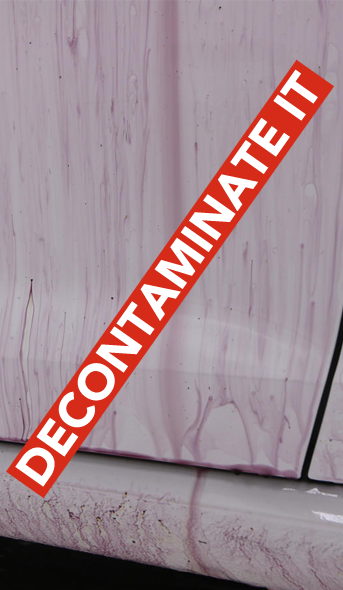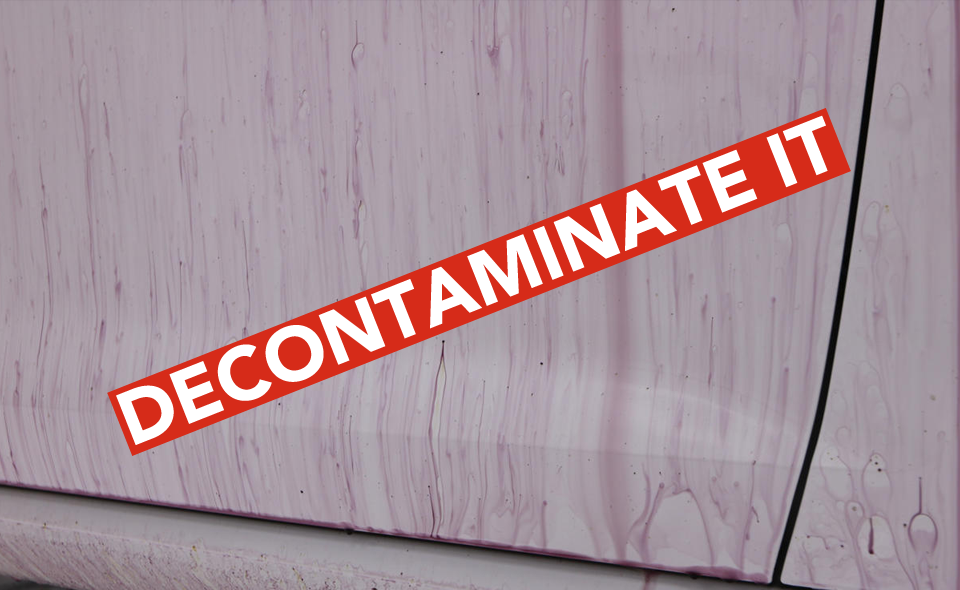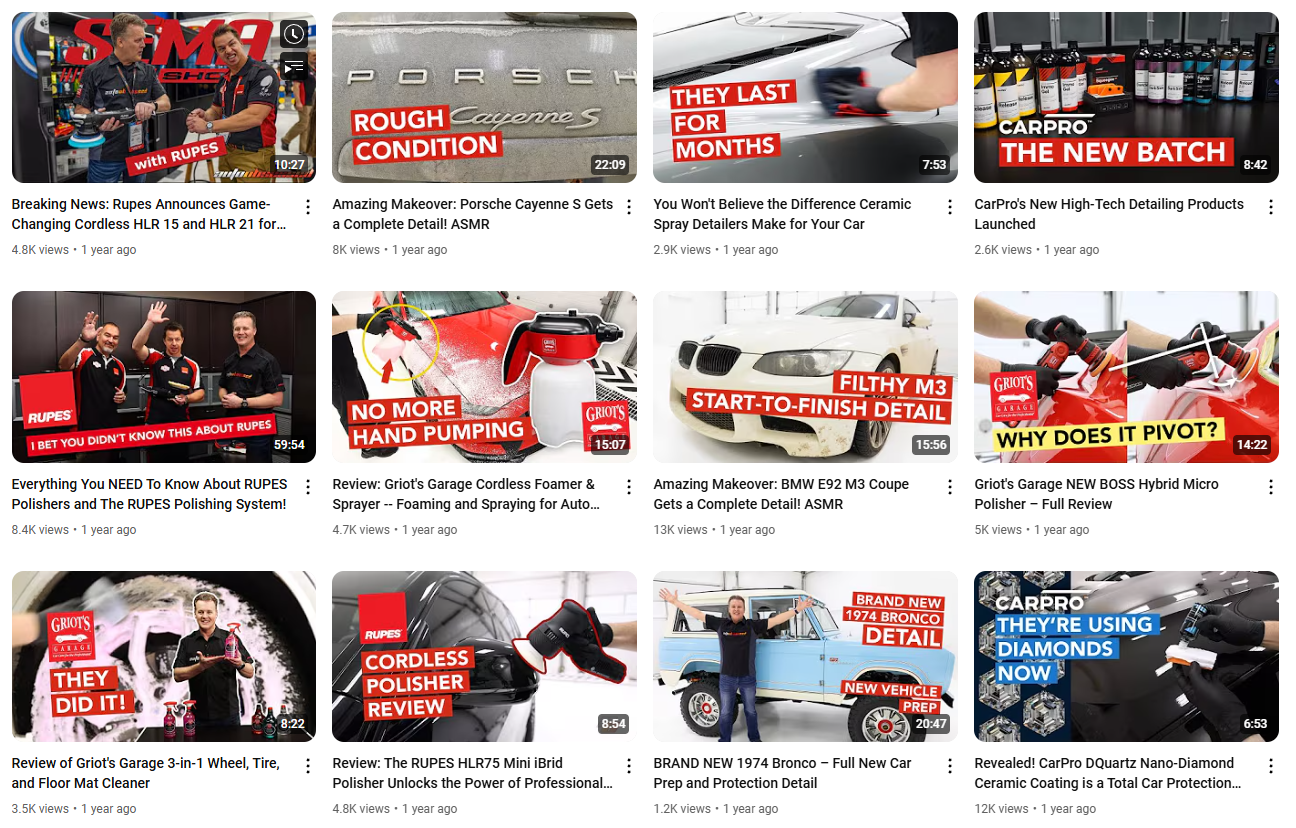Your cart is currently empty.
PAINT PROTECTION / WINDSHIELD FILM
AIR FRESHENER / ODOR ELIMINATOR
PPE / PERSONAL PROTECTIVE EQUIPMENT
PAINT PROTECTION PPF / WINDSHIELD FILM


Over time your vehicles paint can become contaminated with dirt, grime, and other pollutants. Decontaminating your vehicle's is a crucial step that should never be overlooked. Before diving into any paint correction work or applying final protective layers such as paint protection film, wax, sealant, or ceramic coatings, it's essential to thoroughly cleanse the paint to ensure optimal results and long-lasting protection. In this blog post, we’ll explore why this step is so important and how to properly decontaminate your vehicle’s paint to achieve that flawless finish.
What is paint contamination?
Paint contamination refers to the presence of unwanted substances on your car's paint surface. These contaminants can come from various sources and can embed themselves into the paint, making it feel rough and look dull. Here are some common types of paint contaminants:
Tar
Tar from roads can splash onto your car's paint, especially if you drive on newly paved or repaired roads. Tar spots are sticky and can attract more dirt and contaminants.
Iron or Industrial Fallout
Tiny particles from industrial processes, such as metal shavings, rail dust, and pollution, can settle on your car's paint. These particles can bond to the surface and cause damage over time. On light colored vehicles this will show up as orange rust colored spots.
Water Spots
Minerals in water can leave spots on your car's paint after it dries. These spots can be difficult to remove and can etch into the paint if left untreated.
Bug Splatter
Bugs that hit your car while driving can leave behind acidic residues that can damage the paint. Bug splatter can be particularly challenging to remove once it has dried.
Road Salt
In colder climates, road salt is used to melt ice and snow. This salt can splash onto your car and cause corrosion and paint damage if not washed off regularly.
Paint Overspray
Tiny paint particles that settle on your car's surface, leaving it with a rough texture. This is often found on cars that have undergone body work, have been parked near construction zones or vehicles that have driven over fresh road paint.
Tree Sap
Sap from trees can drip onto your car and harden, creating sticky spots that are difficult to remove. If left untreated, tree sap can etch into the paint and cause permanent damage.
Bird Droppings
Bird droppings are acidic and can quickly damage your car's paint if not removed promptly. They can cause etching and discoloration.
Brake Dust
Brake dust from your car's brakes can settle on the paint, especially around the wheels. This dust contains metal particles that can bond to the paint and cause damage.
Regularly decontaminating your car's paint helps remove these substances, protecting the paint and keeping your car looking its best
Precautions:
When decontaminating your car's paint, it's important to take certain precautions to ensure you don't damage the paint or other surfaces. Here are some key precautions to keep in mind:
Use the Right Products
Always use a high-quality clay bar and a dedicated clay lubricant. Using the wrong lubricant can degrade the clay bar or not provide enough lubrication for the clay to glide on the paint.
Spot Test
Before decontaminating the entire car, test the chemicals or clay bar and lubricant on a small, inconspicuous area to ensure they don't cause any adverse reactions. Always test areas with paint protection film or areas of the vehicle that were refinished.
Light Touch
Use gentle pressure when agitating chemicals or using the clay bar. Pressing too hard can cause scratches or marring on the paint surface.
Avoid Direct Sunlight
Decontaminate your car in a shaded area or indoors to prevent the products from drying too quickly and leaving residue on the paint.
Follow Product Instructions
Always follow the manufacturer's instructions for all products used. This ensures you're using them correctly and safely.
Wear Gloves
Consider wearing gloves to protect your hands from chemicals and to maintain a better grip on the tools.
By following these precautions, you can safely and effectively decontaminate your car's paint, keeping it in excellent condition.
How to Decontaminate Your Cars Paint
Maintaining your car's paint is crucial for preserving its appearance and value. Over time, contaminants like tar, tree sap, and industrial fallout can embed themselves in the paint, making it look dull and feel rough. Here's a step-by-step guide to help you decontaminate your car's paint and keep it looking pristine.
What You'll Need:
• Car wash soap
• Microfiber wash mitt
• Decontamination chemicals (Iron, Tar, Sap, Bug or Water Spot Remover)
• Clay bar or Clay mitt
• Polishing compound and polisher
• Clay Lubricant
• Nitrile gloves.
Step-By-Step Guide
1) Wash your car:
Start by giving your car a thorough hand wash to remove loose dirt and grime. Use a strong car wash soap and a wash mitt to clean the surface. Rinse the car well to ensure all soap is removed. The car can remain wet for the next steps.
See our in-depth guide on how to wash your car
2) Inspect the Paint Surface:
After washing, if you cannot see any obvious contamination inspect the paint by running your hand over the surface. If it feels rough, there are likely contaminants embedded in the paint. Common contaminants include Iron, Tar and Tree sap.
3) Chemical Decontamination:
Begin by spraying an Iron Remover directly onto the wet vehicle. Allow it to sit for 3-5 minutes before agitating the surface with a wash mitt. Rinse the vehicle thoroughly and then proceed with the next applicable chemical, such as Tar, Sap or Water Spot remover.
See our in-depth guide on Iron removal
4) Clay Bar (If Required):
Take a small piece of clay and shape it into a disc roughly 2-3 inches in size. Apply clay lube to both the clay and the area you plan to clean. With gentle back-and-forth motions, rub the clay on the car’s surface, focusing on small sections until all contamination has been removed. Regularly fold and re-flatten the clay to reveal a fresh surface, and reapply clay lube to maintain proper lubrication.
See our in-depth guide on claying
5) Re-wash your car:
Once all contamination has been removed and the paintwork feels smooth to the touch, give the vehicle another wash to eliminate any residues left behind by the decontamination chemicals and clay lubricants.
6) Rinse and dry the car:
After washing the car a second time, rinse off any remaining soap residues with clean water. Dry the vehicle with microfiber towels or a blower to prevent water spots and scratches. Now your paint is decontaminated and ready for final protection!
How often do I need to decontaminate my paint?
The frequency of decontaminating your car's paint depends on several factors, including your driving environment, how often you drive, and how well you maintain your car. Here are some general guidelines:
Daily Driven Vehicle: If you drive your car daily or take long trips often, contaminants can build up more quickly. Consider decontaminating your paint every 6 months.
Summer Vehicle: For those special vehicles that are rarely driven or only taken out on nice days you may only need to decontaminate once a year.
Regular Washing: If you wash your car regularly (at least once a week), you can help prevent contaminants from embedding deeply into the paint. This might allow you to decontaminate every 6 months.
Infrequent Washing: If you wash your car less often, contaminants can accumulate more quickly, necessitating decontamination every 3-4 months.
Feel the Paint: Run your hand over the paint surface. If it feels rough, it's time to decontaminate.
Look for Contaminants: Visually inspect the paint for iron spots, tar, or other contaminants. If you notice a buildup, it's time to decontaminate.
By considering these factors, you can determine the best schedule for decontaminating your car's paint. Regular maintenance will help keep your car looking its best and protect the paint from long-term damage.
In this detailing tutorial video, we talk about how to decontaminate your vehicle.
Where To Buy Decontamination Products:
At Auto Obsessed, we understand the importance of maintaining your vehicle's appearance. Our team of experts is here to help you choose the right decontamination products and provide professional application services. Contact us today to learn more and give your car the ultimate protection it deserves.














